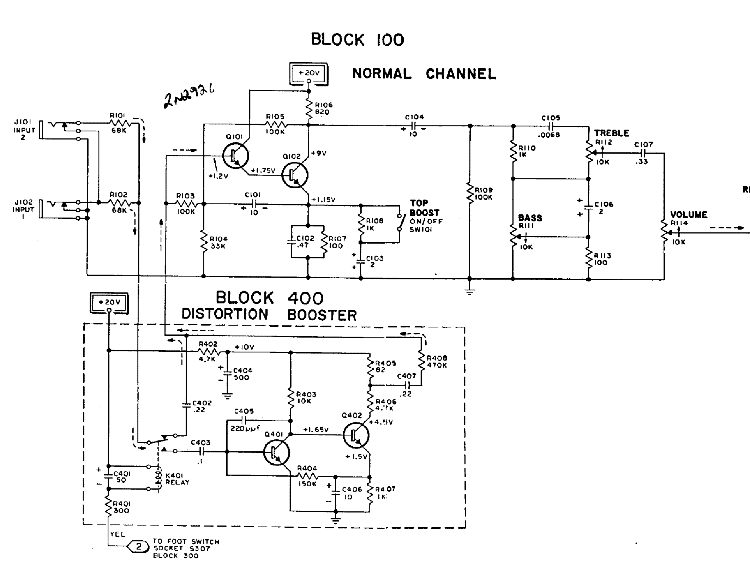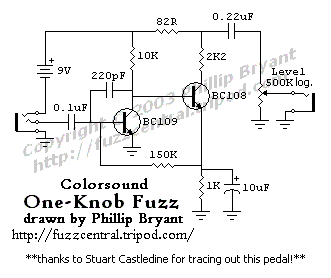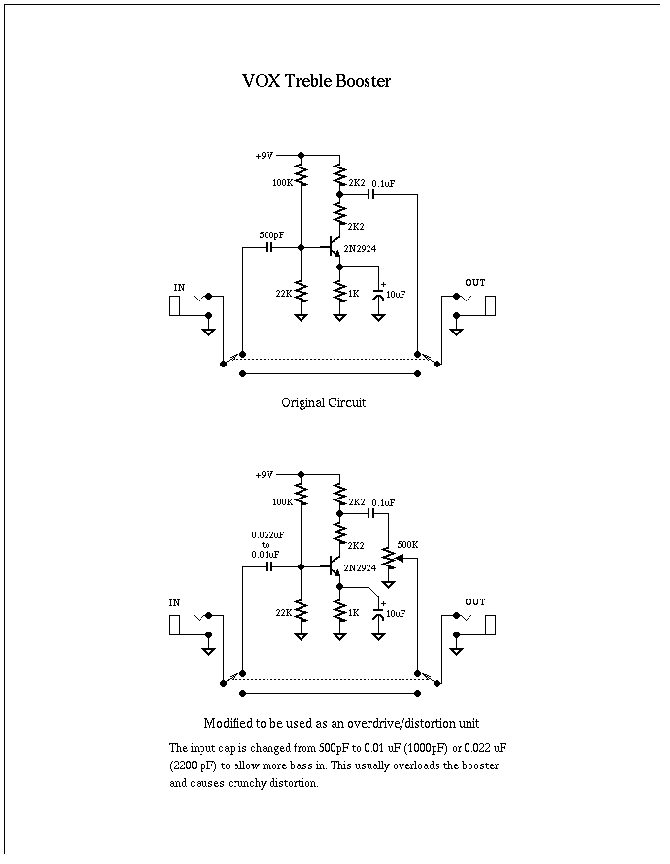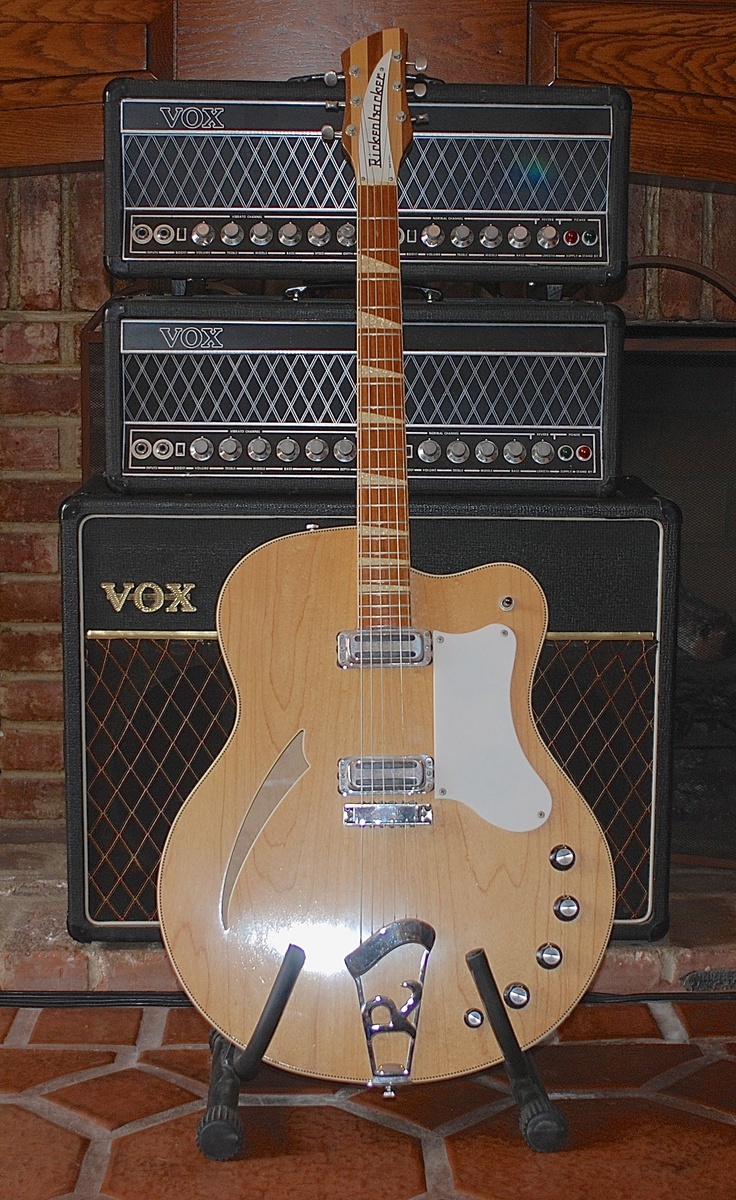Vox Distortion Booster = Colorsound one knob fuzz?
|
Hi there,
Are any of you guys familiar with the different vox distortion booster circuits? I heard that the vox distortion booster in the Super Beatle amp is pretty much the same as the colorsound one knob fuzz. Are the circuits for the Vox distortion booster pedal (the old one) and the one you plugged into your guitar the same? Thanks! |
|
So... I built this:
http://tagboardeffects.blogspot.nl/2012/10/colorsound-one-knob-fuzz.html But changed all the values to this:  I'm terrible at reading schematics (noob!), but from what I can read, I can change all the resistor values. But omitting the 1M. I think that is the pulldown resistor to stop it from popping? Plus the 220p cap is not in the schematic, so I omitted that one. It's exactly the same, right? I don't have the 2N2924s yet, so I tried BC550c's and 2N3904 cause I have those lying around. The fuzz is fine, though not special, but there is a lot of hiss. Is that because the transistors I use are way too high in hfe? Or is the schematic I interpreted wrong? PLease correct me if anything of the above does not make any sense, I'm trying to wrap my head around schematics and part-functionalities... |
Re: Vox Distortion Booster = Colorsound one knob fuzz?
|
The 220p cap on Q2 would help filter out some hiss so I would probably leave that in or at least adjust to taste. The BC550C gain is much higher than the stated 2N2924 so stick with the 2N3904 as its closer. And yes the 1M is a pulldown resistor on the input.
The layout matches the schematic so you're reading all this right. The topology is basic fuzz face. I'd look at some of those schematics and have a play. Simple, low parts count and infinitely tweakable. Love this circuit. |
|
This post was updated on .
In reply to this post by Marbles
Here's the schematic. Yes, it's pretty much the colorsound fuzz.
 
|
|
In reply to this post by Ciaran Haslett
Thanks a lot!
Yeah, it's hard haha. I'm starting to slowly recognise some parts of a circuit. Can spot a pulldown resistor, the input cap for filtering out DC. In some cases a diode to protect against reverse polarity. I guess the cap in the output has the same function as the input cap. Plus creating a high or lowpass filter(?). I think I remember changing the value will affect the highs/lows of the circuit. Slowly starting to see voltage dividers, not in this case but that's because the voltage of Q1 is being set by Q2? That is about all I think I know haha. Maybe this isn't the easiest circuit to understand since the fuzz face is a somewhat weird design with Q2 affecting Q1? From what I can tell, there are a lot of 'standard' things to be found in almost every circuit (the ones I correctly or incorrectly mentioned above haha). Is there information to be found somewhere where it mentions those standard components that are found in every circuit? If I can wrap my head around those, I can maybe easily put those aside in my head when looking at a schematic. I can filter those out and focus on what the other parts do. The 'magic' of the circuit if you will :D If that makes any sense whatsoever If there is info like that, and someone knows, I'd love to hear it! |
|
In reply to this post by Frank_NH
Thanks! Yeah, very much so... :)
|
Re: Vox Distortion Booster = Colorsound one knob fuzz?
|
This post was updated on .
In reply to this post by Marbles
The most significant difference between [the colorsound and the amp version of the distortion booster] and the schematic is that 22k from Q2 emitter to Q1 base: Ignoring the bias resistors on the collectors (which varies slightly between fuzzface variants), the voltage feedback biasing is 100k in the standard fuzzface, is 150k in the vox amp/colorsound (and is pretty ripping), is variable up to 500k in the woolly mammoth (insane) and is a more modest 47k in the fuzzface part of a tonebender MkII (which has another single transistor boost Q1 in front of a fuzzface type Q2+3). I have made a one knob variant of this type of mkII circuit with just about 12k feedback resistor, it works quite well since the gain is maxed with the emitter bypass cap directly on the emitter, but it doesn't squeal feedback and is not extremely noisy. 12k is about the lowest it went before it choked off the input, but as you lower it the sound becomes less spongy and more responsive it that makes any sense: Higher values feel like higher gain, I suspect the reduced amount of negative feedback allows the transistors to clip much earlier. Perhaps this is why both the colorsound and the amp have the 220p cap to mitigate the extra saturation from the bigger feedback resistor value. For circuit block information, Rg Keen's "technology of the fuzzface" is a bit much on first read, but I have returned to it many times over the years. There are many walk-throughs of common circuit arrangements in popular pedals like the LPB1, electra distortion, rangemaster, fuzzface, bmp, fuzzrite, TS, microamp, distortion+ etc which all use common transistor or opamp stages. Beavis, smallbear, rg keen, geofx, homewrecker, rog, Joe gore and many other web resources have explanations of how circuits operate, or what components tweak which characteristics, and if you look into a circuit, you will come across information and discussion from people who have trod this path before us. Perhaps the bigger drawback of choosing the venerable fuzzface to start with is not the slightly unusual voltage feedback biasing, but the sheer vast acres of shit you have to wade through on the internet, much of which appears to revolve around trying to source the perfect Ge transistors. However, with a couple of any old transistors and a breadboard, there are hours of fun to be had playing with values and deciding what you like. An input cap.blend/switch, variable resistor in that 22k spot, variable resistor from Q2 collector to the output cap all provide some cool variation. |
|
Wow, thanks a lot! That's a wealth of information. I'll be reading this a few times, very informative fo rthe point where i'm at now. Thanks for taking the time, very much appreciated.
I have come across 'the technology of the fuzz face' a few times, and you're right, it's a bit daunting. But maybe every time i'll read something sticks :) I will do a better search on the sites you mentioned. I really want to have a better understanding of what I'm doing. I bought a book for basic electronics, but hard to filter what is good to learn and what might be of any importance. So beardboarding would be great. I thought I'd start with an Electra distortion. I thought i understood the schematic, and layed it out on my breadboard. Unfortunately no sound... Maybe I was fighting to get the legs in too much, or didn't put them in deep enough, I don't know.. I'll have to start that over again maybe. From your story that will be key in really experiencing what functionality everything has. Could I bother you guys with another question maybe? In the folowing schematic.. If I was to add a volume control to the top schematic. It means Lug 1 to ground, Lug 2 to output and that line from the outputcap to Lug 3 of a volume pot, right?  It's a lot of questions about Vox circuits haha, I know. Basically I'm trying to box a Vox treblebooster, midfi tape fuzz, Vox Distortion Booster en Vox repeat percussion in one box. It's quite ambitious for me I realise, but hey, who knows. Just not sure about the order yet. |
Re: Vox Distortion Booster = Colorsound one knob fuzz?
|
Yes, you are correct about the lugs for the volume pot.
|
|
Regarding the Vox Super Beatle line of amps. It is well known that the Beatles used Vox 730s on "Revolver" and perhaps into "Sergeant Pepper". One of my favorite tones of all time is the lead guitar sound (played by Paul) on "Paperback Writer". This tone is comprised, I believe, by his Epiphone Casino (hollowbody with with P90s) and a Vox 730 amp with it's power stage overdriven (no fuzz). The video below shows off this tone at about 3:14 (he plays a Who riff rather than Beatles...). What stompbox can approximate that kind of tone (maybe a BSIAB2 or similar high gainer)?
As for fuzz, it's demoed at 5:09 in the video. Oddly, he plays the "Paperback Writer" riff with fuzz, though fuzz wasn't used on that track. Anyhow, sounds like a one-knob silicon fuzz. |
|
Administrator
|
Wow as a big Beatles fan I really enjoyed this post Frank. Thanks!
That video was great. Watching that guy rock out was awesome, and he has a sweet collection. I see a Marshall supa fuzz next to the head. It is weird that he played paperback writer with the fuzz but the fuzz sounded great when he played revolution Now I'm lusting for a vox 730. An amp I didn't know existed until now  I wonder if being a ss/tube hybrid makes it any easier to clone? |
|
Thanks. If you're a big Beatles fan, you'll enjoy this video (link below) of takes one and two of "Paperback Writer". You'll hear the overdriven lead guitar in isolation and with the rhythm track and vocals. That's the sound of the Vox 730. (Note that the Vox 730 has a solid state preamp (above) and a tube power stage).
http://www.zippcast.com/video/6315cf395fd2f794620 |
|
In reply to this post by Frank_NH
Thanks! That's great.
Weren't these solid state Vox amps used by The Stooges, MC5 and Velvet Underground as well? Sounds great anyway. Love that Beatles tone! That clip in your last post of Paperback Writer, man that is an awesome guitar tone. But I love the fuzzy sound in that 730 clip too. When he cranks the amp and plays Jimi Hendrix... It's not a Jimi sound to me at all, but man I love it. I want to get close to that. I hope I can with that distortion booster. I modified the colorsound one knob to distortion booster specs, but so far it does not have that fuzzy sound. It's a bit too smooth. That was with 2n3904s though. I will be receiving some 2N2924s in the mail today hopefully. I don't think it will make that big of a difference, but who knows? I also built that Treble Booster. It removes the lows, but does not Boost. Could that be because of the 500K pot I used? It's exactly unity when it's fully open. I didnt have a 2N2924 for that either, so used a 2N5088 just to see if that circuit worked. Could that be a reason? If this is becoming too much of a 'Marc tries to build every built in Vox-effect known to man and needs help every step of the way'-thread I understand and can make different threads. I also just finished the Vox Repeater and that sounds awesome (though have to trouble shoot the clicking if possible). But then again, all these questions have made me want that great sounding amp Frank :D |
|
If you have a fetish for Vox 730 amps, here are some good links:
http://vox.opensure.net/Vox_UL730_gallery.html http://www.voxshowroom.com/uk/amp/730.html And, for the ultimate in RARE, here's a cool rare late sixties Rickenbacker 360F next to rare Vox 730...  
|
«
Return to Open Chat
|
1 view|%1 views
| Free forum by Nabble | Edit this page |

